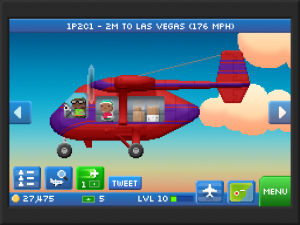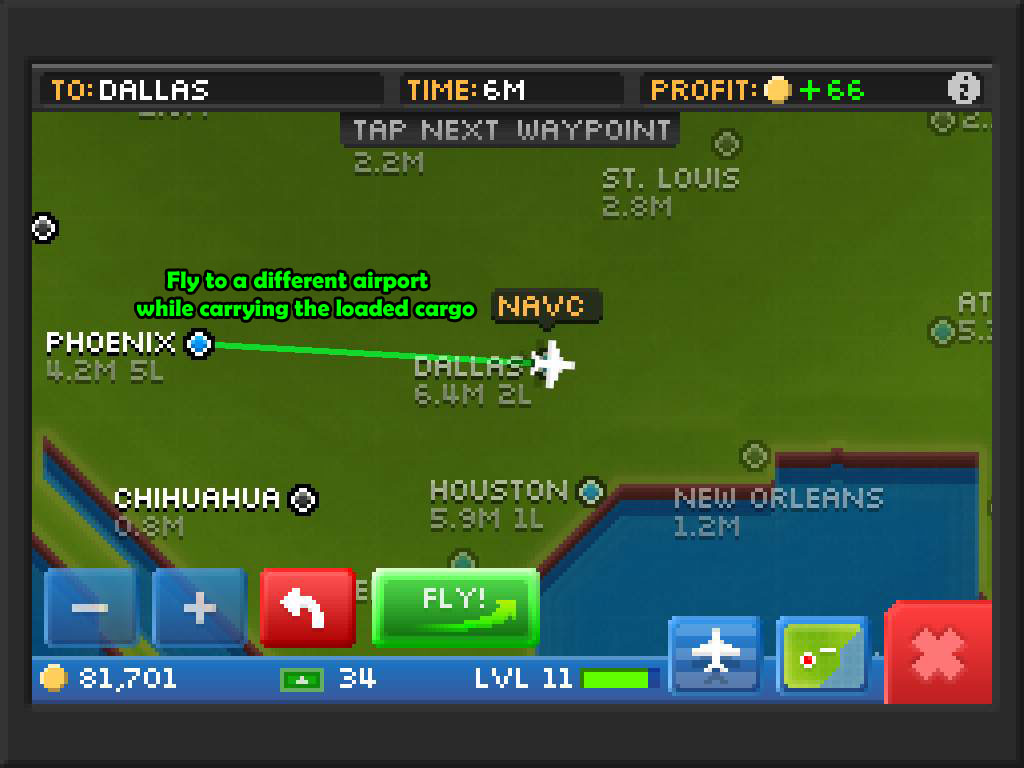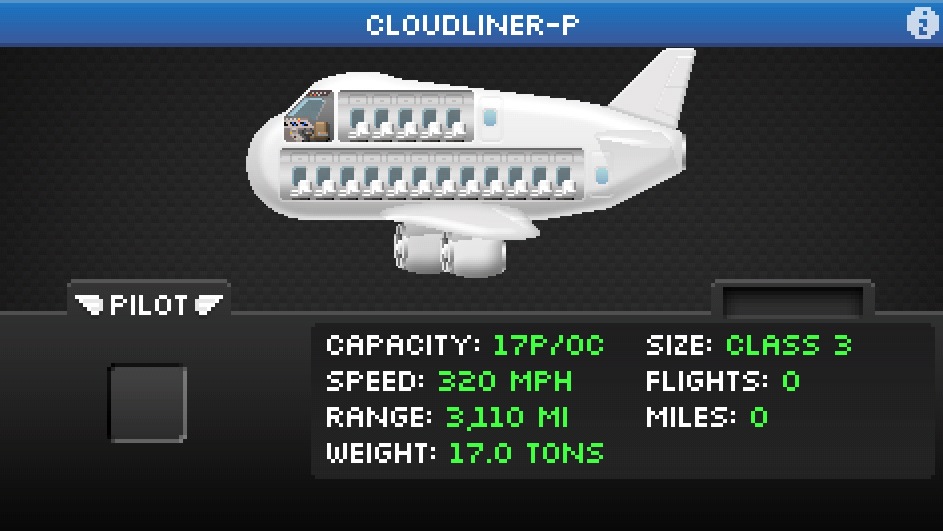Whenever possible try to pack ALL of the slots in your plane for deliveries because when you do you will be rewarded with a bonus. Head back to our Pocket Planes cheats page for a load more cheats and tips for Pocket Planes. In block planes for technical reasons the iron has the bevel upwards in the bed of the plane. If the manufacturer says, e.g., 'iron angle 20°', you have to add on the bevel angle, of, e.g., 25°.
Pocket Planes Guide
There are two common questions in Pocket Planes. 1) How much experience do I earn from a flight? 2) How is profit and flight cost determined?
When you have earned enough bux, you can trade them in for coins to help expand your airline. Establishing a new route at an airport you currently do not fly to, adding an additional flight slot to your airline’s list of flights, and purchasing additional planes will each cost you big bux.
I answered the experience question in a previous post, which I’ll elaborate on more in the next few days. Today I will explain flight profit and cost, how it is calculated and how it all breaks down.
Profit
Profit = Revenue – Expense
That’s pretty simple right? The profit you earn on a flight is a result of the total revenue from the flight, minus the total cost to get the aircraft to it’s final destination.
So how is flight cost, i.e. expense from the equation above, calculated?
Flight Cost/Expense
Expense = Distance * Speed * Weight / 400
The total flight cost from point A to point B is a direct result of distance, speed and weight.
Distance is determined by a straight line between the two locations and is about 1/4 to 1/5 the “real world” distance.
Speed and Weight are determined by the aircraft itself. Each aircraft has it’s own statistics and speed and weight can both be enhanced by upgrading the aircraft.
Distance Between Two Cities
Distance = Revenue per item – 50
Distance is actually very easy to determine in Pocket Planes. The revenue per item you are transporting from A to B is 50 coins more than the total miles traveled. So if you are transporting a Wedding Cake for $247 coins, the actual distance traveled is 247 – 50, or 197 miles.
Revenue Per Item
Revenue = Distance + 50
This is directly tied to distance, which you can see above. Revenue is the total distance plus 50. So If you are carrying cargo 200 miles, your revenue for that item would be 250 per item.
Maximum Revenue Per Flight

Since we now know the basics on how revenue and flight cost is calculated, we easily apply this to the number of slots in our aircraft to determine it’s maximum earning potential between two cities.
Max Revenue = Number of Slots * (Distance + 50)
So a Class 2 Pearjet with 5 slots traveling 500 miles can be represented as:
$2,750 = 5 * (500 miles + 50)
Calculating Profit in Pocket Planes
With all of the information above we have the basics behind the calculations in Pocket Planes. So taking that information and putting it all together, we can calculate our profit per flight between two cities:
Profit = Number of slots * (Distance + 50) – Distance * Speed * Weight / 400
An example below shows a Birchcraft Class 2 airplane carrying 4 pieces of cargo at $197 per item. This aircraft has a speed of 183 and a weight of 4 and is traveling a distance of 147 miles.
$591 = 4 * (147 + 50) – 147 * 183 * 4 / 400
Increasing Profit Per Flight
Since we know the calculations from above, it’s plain to see that we can increase our profit by reducing the weight of a flight. This is done because it decreases the Distance * Speed * Weight / 400 portion of the equation. A lower weight means a lower overall cost of the flight.
Conversely, increasing the speed of a flight actually decreases the profit earned on the flight. However, it increases the long-term earning potential of the aircraft, known as “profit rate.” This is because we can complete more flights per hour with a faster speed, and thus generate more revenue over the long haul.

With this in mind, the aircraft receiving the highest boost in profit from reducing weight can be calculated via the following equation:
Profit Increase Per Flight = .05 / (((400 * Number of Slots) / (Speed * Weight)) – 1)
If you plug the numbers you’ll find the Fogbuster aircraft receives the highest boost per weight decrease, coming in around 18%. It’s followed by the Tetra, Cyclone and Pearjet. I’ll have a detailed breakdown per aircraft posted in a few days for your reference.
Summing Up
I hope you all find this information helpful. I have a handy spreadsheet I am putting together for everyone to download and easily calculation all of this information for you automatically. It will also calculate your experience as well. Check back in a few days and I hope to have this information ready for you!
Follow me on Twitter: http://twitter.com/tekn0wledg and checkout my YouTube Channel for more video updates! Friend me on GameCenter: tekn0wledg
There are two common questions in Pocket Planes. 1) How much experience do I earn from a flight? 2) How is profit and flight cost determined?
I answered the experience question in a previous post, which I’ll elaborate on more in the next few days. Today I will explain flight profit and cost, how it is calculated and how it all breaks down.
Profit
Profit = Revenue – Expense
That’s pretty simple right? The profit you earn on a flight is a result of the total revenue from the flight, minus the total cost to get the aircraft to it’s final destination.
So how is flight cost, i.e. expense from the equation above, calculated?
Flight Cost/Expense
Expense = Distance * Speed * Weight / 400
The total flight cost from point A to point B is a direct result of distance, speed and weight.
Distance is determined by a straight line between the two locations and is about 1/4 to 1/5 the “real world” distance.
Speed and Weight are determined by the aircraft itself. Each aircraft has it’s own statistics and speed and weight can both be enhanced by upgrading the aircraft.
Distance Between Two Cities
Distance = Revenue per item – 50
Distance is actually very easy to determine in Pocket Planes. The revenue per item you are transporting from A to B is 50 coins more than the total miles traveled. So if you are transporting a Wedding Cake for $247 coins, the actual distance traveled is 247 – 50, or 197 miles.
Revenue Per Item
Revenue = Distance + 50
This is directly tied to distance, which you can see above. Revenue is the total distance plus 50. So If you are carrying cargo 200 miles, your revenue for that item would be 250 per item.
Maximum Revenue Per Flight
Since we now know the basics on how revenue and flight cost is calculated, we easily apply this to the number of slots in our aircraft to determine it’s maximum earning potential between two cities.
Max Revenue = Number of Slots * (Distance + 50)
So a Class 2 Pearjet with 5 slots traveling 500 miles can be represented as:

Pocket Planes Game
$2,750 = 5 * (500 miles + 50)
Calculating Profit in Pocket Planes
With all of the information above we have the basics behind the calculations in Pocket Planes. So taking that information and putting it all together, we can calculate our profit per flight between two cities:
Profit = Number of slots * (Distance + 50) – Distance * Speed * Weight / 400
An example below shows a Birchcraft Class 2 airplane carrying 4 pieces of cargo at $197 per item. This aircraft has a speed of 183 and a weight of 4 and is traveling a distance of 147 miles.
$591 = 4 * (147 + 50) – 147 * 183 * 4 / 400
Increasing Profit Per Flight
Since we know the calculations from above, it’s plain to see that we can increase our profit by reducing the weight of a flight. This is done because it decreases the Distance * Speed * Weight / 400 portion of the equation. A lower weight means a lower overall cost of the flight.

Conversely, increasing the speed of a flight actually decreases the profit earned on the flight. However, it increases the long-term earning potential of the aircraft, known as “profit rate.” This is because we can complete more flights per hour with a faster speed, and thus generate more revenue over the long haul.
Pocket Planes Max Plane Slots
With this in mind, the aircraft receiving the highest boost in profit from reducing weight can be calculated via the following equation:
Profit Increase Per Flight = .05 / (((400 * Number of Slots) / (Speed * Weight)) – 1)
If you plug the numbers you’ll find the Fogbuster aircraft receives the highest boost per weight decrease, coming in around 18%. It’s followed by the Tetra, Cyclone and Pearjet. I’ll have a detailed breakdown per aircraft posted in a few days for your reference.
Summing Up

I hope you all find this information helpful. I have a handy spreadsheet I am putting together for everyone to download and easily calculation all of this information for you automatically. It will also calculate your experience as well. Check back in a few days and I hope to have this information ready for you!
Follow me on Twitter: http://twitter.com/tekn0wledg and checkout my YouTube Channel for more video updates! Friend me on GameCenter: tekn0wledg